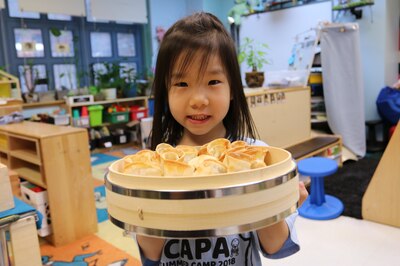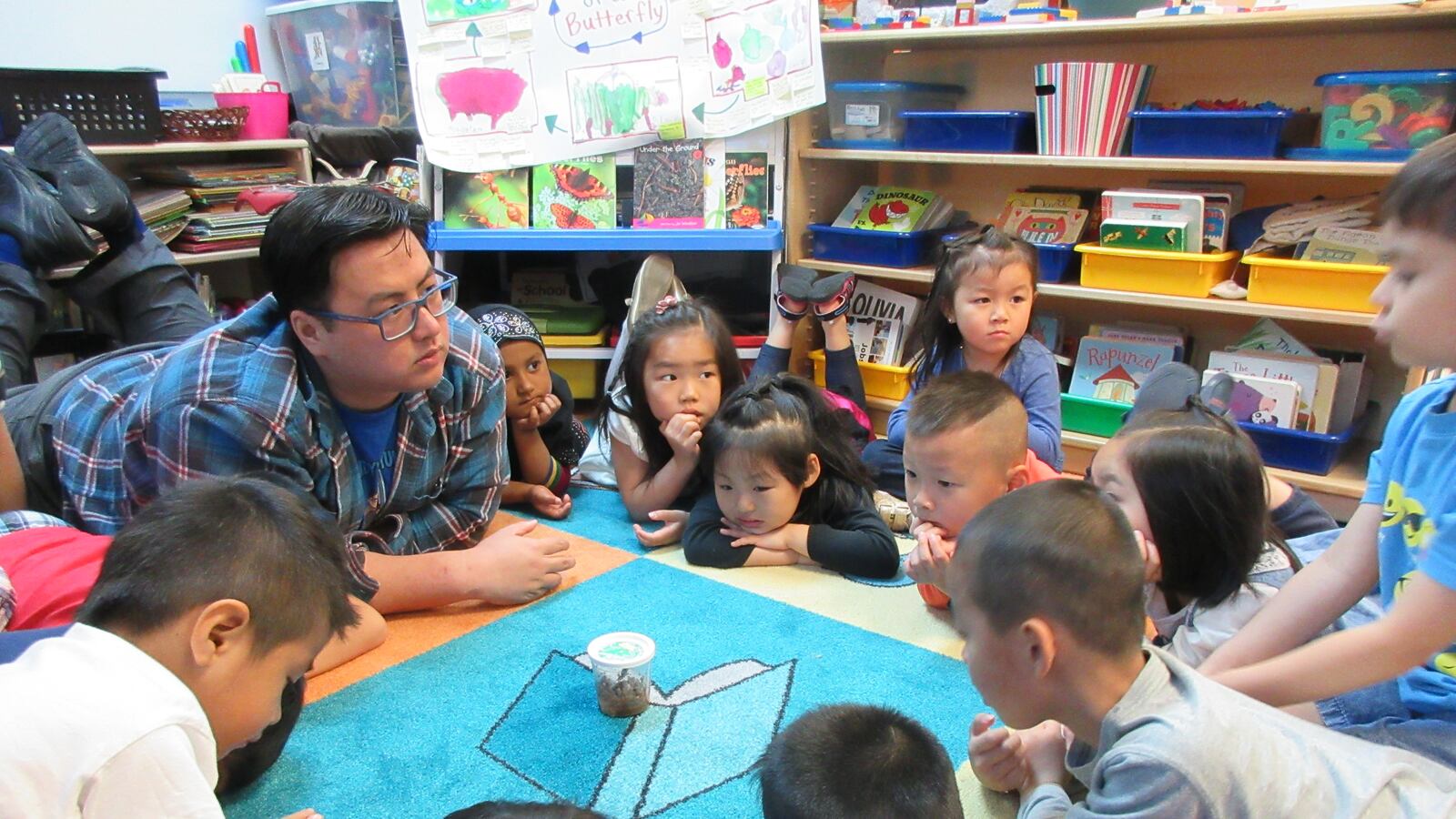It would be easy to infer that when parents don’t show up to teacher conferences or school events at P.S. 244, the Active Learning School, it is simply because they don’t care. But Andy Yung, a pre-K teacher at the school, knows better.
Yung grew up in the same Flushing neighborhood where he now teaches. When he was young, his own immigrant parents had to work extremely long hours to keep the family afloat — and he knows many of his students’ families have to do the same.
Last school year, Yung downloaded the messaging app WeChat, popular in the largely Chinese-speaking community he serves. Using the translate feature, he was able to begin texting with parents — some of whom work out of state — and to schedule video conferences with them.
“They were very appreciative of that, and there was such a big trust that we built with each other,” Yung said. “It’s not that the parents don’t care. They care a lot. That’s why they made so many sacrifices.”
Yung also tries to connect with families in the neighborhood by patronizing local businesses run by his students’ families.
“Just to show them, ‘I’m so glad you support what I do for your children. I want to support what you do,’” he said.
The visits can be especially helpful for building rapport with parents who may be uncomfortable with a male teacher at the head of a pre-K classroom. Nationwide, only about 2% of pre-K and kindergarten teachers are men, federal statistics show.
Speaking with Chalkbeat, Yung told us how he got over a preoccupation with academics to create a more playful pre-K classroom, why a pair of scissors are among his most prized teaching tools, and how his school helps students adjust to the classroom when they’ve spent much of their lives abroad, away from their parents.
This interview has been edited for length and clarity.
How do you get to know your students?
In the beginning of the year, I send our families surveys to ask for information about my students. I can also find out a lot about them by observing which play centers they gravitate towards. As they are engaged in play, I find out a lot about their likes, dislikes, family, what they know, and so much more by just watching as they interact with peers. But I also step in to ask questions because when they’re playing, they’re in a place of comfort and it’s easier for them to open up.
Tell us about a favorite lesson to teach. Where did the idea come from?
Two years ago, one of my students, Adele, was in the play dough center and she was happily molding play dough into a dumpling. I asked what she was making but she was hesitant to tell. When I asked her if it was a dumpling she confirmed it with a nod and a beautiful smile. She shared with me that she made them with her mom at home. She had always been shy and reserved but this topic was something she felt very comfortable talking about. That moment inspired my idea to bring the dumpling-making experience into the classroom.

The project was funded through DonorsChoose.org. We received resources, such as fiction and non-fiction books about dumplings, tools that help us make dumplings, and appliances to cook dumplings. However, we did not have enough time left in the school year to actually make dumplings.
Summer was around the corner and a handful of our students also enroll in a camp that’s housed in the school building. There, we read the books that introduced characters that were familiar to their own backgrounds and topics that our kids are familiar with. Dumplings, dim sum or yum cha, xiaolongbao — all the different vocabulary that seemed to be only used when they were with their families were now a part of our language in school.
I wanted Adele to experience making and cooking real dumplings in the classroom. Luckily, she also attended the summer camp. With permission from her teacher, she came to our class to show us how she made the dough and stuffed the dumpling.
What object would you be helpless without during the school day?
I’ve made it a mission to reduce the amount of waste in our classroom. We do our best to reduce, reuse, recycle, and repurpose. You’ll find milk containers in the art center, and yogurt tops in the paint center. One thing that I would be helpless without is my cardboard scissors. It makes cutting cardboard so much easier since our students find brilliant ways to use cardboard, paper towel rolls, and other recyclable materials. With my cardboard scissors, I am able to help them change cardboard into the desired shape they have imagined for their masterpiece artwork.
What’s something happening in the community that affects what goes on inside your class?
Many of our families work extremely long hours, every day of the week, to provide for their family. They depend on family for help. For a lot of them, that family is often overseas. They make the difficult decision to send their newborn back to China for their extended family to care for until they are of school age. A handful arrive the day before school starts and are expected to adjust to a new country, a new language, a new house, a new bed, and parents they rarely saw in person.
There’s a term for children who go through this. They are called satellite babies. Children who go through this experience, as you could imagine, have a very difficult time adjusting to the school setting. Their parents also have a difficult time connecting with them because to the child, their parents are strangers.
They, and other families, sometimes resort to giving their children lots of screen time in the form of tablets, computers, televisions, or smartphones to keep their child busy and because there’s a misconception that these devices will help their child learn more. In some situations, our children will exhibit behaviors associated with detrimental effects of excessive screen use, resulting in limited social skills and inability to regulate their emotions in a healthy way.
We do our best to inform our parents of excessive screen use and provide alternative activities they can engage in with their child. These are often in the form of parent engagement workshops, individual conferences, and providing resources for families to take home.
What was your biggest misconception that you initially brought to teaching?
When I began teaching, the educational buzzword at the time was “academic rigor.” Being an ambitious first-year pre-k teacher, I had a false pretense about what my students needed to be ready for kindergarten.
I believed a 5-year old had to know all of his letters, sounds, numbers, and may be able to read by the end of the year. I was very wrong. My initial lessons with my class went horribly, and I had to change quickly before I got burned out by the end of my first year.
I consulted with administration, colleagues, and friends to discuss developmentally appropriate learning practices for pre-k, and I visited some of the most prestigious private, play-based programs in the city. I’ve stuck with a play-based approach ever since.
What are you reading for enjoyment?
I am currently a Ravenclaw Wizard thanks to Niantic’s augmented reality game, Harry Potter: Wizards Unite. I have since become very interested in the Harry Potter universe lore and I am reading the Harry Potter series by J.K. Rowling. (Late to the party, I know.)
I have also become more proactive in bringing books that are more reflective of my students’ experiences. I am seeking out books that are by authors of color and books with characters that are relatable to my students. The task has proven to be difficult due to the lack of literature that meets my criteria. Therefore, I have embarked on the journey of writing my own picture book. To guide my research for my book, I am reading “Show Me a Story: Why Picture Books Matter, Conversations with 21 of the World’s Most Celebrated Illustrators by Leonard S. Marcus.”
Tell us about a memorable time — good or bad — when contact with a student’s family changed your perspective or approach.
I grew up in the same community I teach, so I know how difficult it can be for families to make ends meet. In our community, it isn’t uncommon for children to be cared for by their grandparents full time while their parents work out of state in a restaurant or nail salon business. One student of mine would get dropped off and picked up by her dad most of the time. Her dad had a visible disability. Every once in a while, her mom would drop her off and pick her up. One morning, the mom had time to stick around for a bit after arrival.
She sat down to play with her daughter, whom she rarely gets to see. My paraprofessional and I were able to have a discussion with her. She revealed to us that she works out of state at a nail salon that was her own business. When we asked why she opened a business out of state, she told us there was less competition there than in New York. She needed the business to do well because she had to become the sole provider after her husband was in a car accident.
The mother comes back once a week to visit on her day off. On that same day during naptime, her child began to cry quietly. I asked if she was OK, and she just sniffled and said, “Mama.” I knew the reason she was overwhelmed with sadness was because her mother’s stay was over and the long wait for her to come back would begin again.
My own parents would work seven days a week and over 12 hours each day. I would occasionally see them in the morning before leaving for school and during dinner at night. I want that child and all my other students who rarely get to see their parents to know that I understand what they are going through because I was like them, and I am here for them now.
When they look at me, I want them to think, “I see me!”

